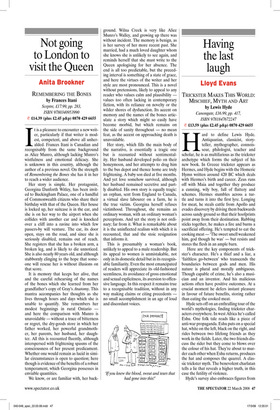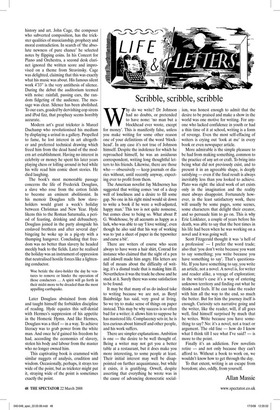Having the last laugh
Lloyd Evans
TRICKSTER MAKES THIS WORLD: MISCHIEF, MYTH AND ART by Lewis Hyde Canongate, £16.99, pp. 417, ISBN 9781847672247 ✆ £13.59 (plus £2.45 p&p) 0870 429 6655 Hard to define Lewis Hyde. Antiquarian, classicist, storyteller, mythographer, connoisseur, philologist, teacher and scholar, he is as multifarious as the trickster archetype which forms the subject of his new book. In Greece trickster appears as Hermes, and Hyde begins with the Homeric Hymn written around 420 BC which deals with Hermes’s birth and career. Zeus runs off with Maia and together they produce a cunning, wily boy, full of flattery and schemes. Hermes stumbles across a turtle and turns it into the first lyre. Longing for meat, he steals cattle from Apollo and evades discovery by driving them backwards across sandy ground so that their hoofprints point away from their destination. Rubbing sticks together, he makes a fire and burns a sacrificial offering. He’s tempted to eat the cooking meat — ‘The sweet smell weakened him, god though he was’ — but resists and stores the flesh in an ample barn.
Here are the key components of trickster’s character. He’s a thief and a liar, a ‘faithless go-between’ who transcends the boundaries between gods and men. His nature is plural and morally ambiguous. Though capable of crime, he’s also a musician and an inventor. And his malicious actions often have positive outcomes. At a crucial moment he defers instant pleasure in favour of future benefits, storing rather than eating the cooked meat.
Hyde sets off on an enthralling tour of the world’s mythologies, finding trickster characters everywhere. In west Africa he’s called Eshu. One folk tale reads like a piece of anti-war propaganda. Eshu puts on a special hat, white on the left, black on the right, and rides between two lifelong friends as they work in the fields. Later, the two friends discuss the rider but they come to blows over the colour of his hat. They’re about to murder each other when Eshu returns, produces the hat and composes the quarrel. A classic trickster myth. The benevolent charlatan tells a lie that reveals a higher truth, in this case the futility of violence.
Hyde’s survey also embraces figures from history and art. John Cage, the composer who subverted composition, has the trickster qualities of musicianship, prophecy and moral contradiction. In search of ‘the absolute newness of pure chance’ he selected notes by flipping coins. In his Concert for Piano and Orchestra, a second desk clarinet ignored the written score and improvised on a theme from Stravinsky. Cage was delighted, claiming that this was exactly what his music was about. His famous silent work 4’33” is the very antithesis of silence. During the debut the auditorium teemed with noise: rainfall, passing cars, the random fidgeting of the audience. The message was clear. Silence has been abolished. To our ears, goaded by dervishing cop sirens and iPod fizz, that prophecy seems horribly accurate.
Modern art’s great trickster is Marcel Duchamp who revolutionised his medium by displaying a urinal in a gallery. Propelled to fame, he lost interest in art altogether and preferred technical drawing which freed him from the dead hand of the modern art establishment. Having no interest in celebrity or money he spent his later years playing chess or lolling around in bed while his wife read him comic short stories. He died laughing.
The book’s most memorable passage concerns the life of Frederick Douglass, a slave who rose from the cotton fields to become an eminent abolitionist. In his memoir Douglass tells how slaveholders would grant a week’s holiday between Christmas and New Year. Hyde likens this to the Roman Saturnalia, a period of feasting, drinking and debauchery. Douglass joined in the party alongside his enslaved brethren and after several days’ bingeing he woke up in a pig-sty with a thumping hangover. Concluding that freedom was no better than slavery he headed meekly back to the fields. Later he realised the holiday was an instrument of oppression that neutralised hostile forces like a lightening conductor.
Woe betide the slave-holder the day he ventures to remove or hinder the operation of those conductors ... A spirit will go forth in their midst more to be dreaded than the most appalling earthquake.
Later Douglass abstained from drink and taught himself the forbidden discipline of reading. Hyde equates this self-denial with Hermes’s suppression of his appetite in the Homeric Hymn. And like Hermes, Douglass was a thief — in a way. To achieve literacy was to grab power from the white man. And once he’d gained his freedom he had, according the economics of slavery, stolen his body and labour from the master who no longer owned him.
This captivating book is crammed with similar nuggets of analysis, erudition and wisdom. Occasionally, perhaps, it strays too wide of the point, but as trickster might put it, straying wide of the point is sometimes exactly the point.



















































































 Previous page
Previous page